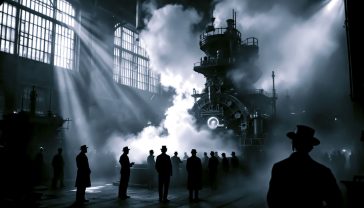The Unsung Heroes of Progress: Railways of the Industrial Revolution
Discover how steam and iron forged modern Britain. This definitive guide covers the pioneers, the engineering feats, and the revolution that changed a nation.

This post may contain affiliate links. If you make a purchase through these links, we may earn a commission at no additional cost to you.
Imagine a Britain where the fastest thing on land was a galloping horse. A world where a trip from London to Manchester, a journey we now make in just over two hours, would have taken you the best part of two days. Fresh food was a local affair, industries were small, and the idea of a national culture, where everyone knew the same news and shared the same trends, was almost unthinkable. This was Britain right before everything changed. And the change came thundering down a pair of iron tracks.
This isn’t just a story about steam engines and metal rails. It’s the story of how a revolutionary new technology completely reshaped a nation. The railways were the veins and arteries of the Industrial Revolution, pumping coal, iron, and people around the country at speeds that were once unimaginable. They turned tiny villages into bustling towns, created fortunes overnight, and stitched together the fabric of modern Britain. So, grab a brew, settle in, and let’s take a journey back in time to discover the unsung heroes of progress: the incredible railways of the Industrial Revolution.
The World Before Steam: A Slow and Bumpy Ride
Before the age of steam, Britain moved at a crawl. The transport system was a patchwork of bumpy roads and winding canals.
Life on the Road
The roads were, to put it mildly, a bit of a mess. Most were little more than muddy tracks, turning into boggy nightmares every time it rained. A long-distance journey in a horse-drawn coach was an uncomfortable, bone-rattling ordeal that could take days. Highwaymen, like the famous Dick Turpin, were a real threat, making travel dangerous as well as slow.
Transporting heavy goods was even harder. Big, bulky materials like coal or iron had to be moved by convoys of packhorses or lumbering wagons. It was incredibly expensive and inefficient. A factory owner in Manchester might have to wait weeks for a shipment of raw cotton to arrive from the port of Liverpool, just 35 miles away. This massive bottleneck was holding back the growth of industry.
The Canal Age: A Step in the Right Direction
Canals were a big improvement. From the mid-18th century, a network of man-made waterways began to spread across the country. Barges pulled by horses could carry much heavier loads than wagons, and the journey was smoother. The Duke of Bridgewater’s Canal, opened in 1761 to carry coal from his mines in Worsley to Manchester, is a famous example. It halved the price of coal in the city and kick-started a canal-building boom.
But canals had their limits. They were slow, with boats travelling at a walking pace. They could freeze over in winter, bringing everything to a standstill. And building them was a huge undertaking, involving digging massive trenches and constructing locks to go up and down hills. Britain needed something faster, more reliable, and more powerful. The stage was set for a new hero to enter.
The Birth of the Iron Horse: From Coal Pits to National Network
The idea of running wagons on wooden or iron rails wasn’t new. For centuries, ‘waggonways’ had been used to haul coal out of mines. These early tracks made it easier for horses to pull heavy loads. The real game-changer was finding a way to make the wagons move by themselves.
Early Steam Engines: Pumping and Puffing
The first steam engines weren’t for transport at all. Thomas Newcomen invented a steam-powered pump in 1712 to get water out of flooded mines. Later, James Watt made huge improvements to the design, making it much more efficient. These stationary engines were the powerhouses of the early factories, but they were far too big and heavy to put on wheels.
Richard Trevithick: The First Pioneer
The man who first put a steam engine on rails was a Cornish engineer named Richard Trevithick. In 1804, his unnamed steam locomotive successfully hauled 10 tons of iron and 70 men nearly ten miles along a track in South Wales. It was a groundbreaking achievement, but his engine was so heavy it kept breaking the cast iron rails. Trevithick’s inventions were ahead of their time, and he sadly died in poverty. However, he had proved that it could be done.
George Stephenson: The ‘Father of the Railways’
The man who truly brought all the pieces together was George Stephenson. A self-taught engineer from a poor mining family in Northumberland, Stephenson had spent his life working with steam engines in coal mines. He understood the technology inside out.
He built his first locomotive, the Blücher, in 1814 to haul coal at a colliery. But his real vision was grander. He believed that steam locomotives could carry goods and passengers across the country.
The Stockton and Darlington Railway (1825)
Stephenson’s first big project was the Stockton and Darlington Railway. Its main purpose was to transport coal from the mines near Shildon to the port of Stockton-on-Tees. On 27 September 1825, the railway officially opened. Stephenson himself drove the engine, Locomotion No. 1, pulling a train of coal wagons and a specially designed passenger carriage called Experiment. Hundreds of people turned out to watch, many of them sceptical. The train reached a top speed of 15 miles per hour – astonishing for the time. It was the world’s first public railway to use steam locomotives, and it was a roaring success.
The Liverpool and Manchester Railway (1830)
The next project was even more ambitious. The merchants of the booming industrial city of Manchester and the bustling port of Liverpool were fed up with the slow and expensive canals. They wanted a railway to link the two cities.
This time, the project’s directors held a competition to find the best locomotive for the job. The Rainhill Trials of 1829 were a major public event. Several engines competed, but the winner, by a long shot, was Stephenson’s entry, the Rocket. Co-designed with his son Robert, the Rocket was a masterpiece of engineering. Its multi-tube boiler was far more efficient than previous designs, allowing it to reach an incredible speed of 30 miles per hour.
The Liverpool and Manchester Railway opened in 1830. It was the first railway to be entirely steam-powered, the first to run a scheduled passenger service between two cities, and the first to use a double track. It was the blueprint for the modern railway. The age of steam had truly arrived.
Railway Mania: Forging a Nation of Iron
The success of the Liverpool and Manchester line sparked a frenzy of investment and construction that became known as ‘Railway Mania’. Everyone, it seemed, wanted to get in on the action.
The Investment Boom
Between 1830 and 1850, Britain was gripped by a speculative fever. Railway companies sprang up everywhere, each promising to build new lines that would connect towns and cities across the land. People from all walks of life, from wealthy aristocrats to middle-class shopkeepers, invested their savings, hoping to make a fortune. Parliament was flooded with proposals for new railway lines.
This boom was a bit like the dot-com bubble of the 1990s. Some people made vast sums of money, while others lost everything when speculative companies collapsed. But through all the chaos, an incredible national network of railways was built at a breathtaking pace. By 1850, over 6,000 miles of track had been laid, connecting all of Britain’s major towns and cities.
The Navvies: Building the Lines
This monumental task was carried out by an army of labourers known as ‘navvies’. The name came from ‘navigator’, the term for the men who had dug the canals. These were tough, hard-working men, many of them from Ireland, who lived in temporary camps along the route of the new lines.
Their work was back-breaking and incredibly dangerous. Using little more than picks, shovels, and gunpowder, they shifted millions of tons of earth. They dug cuttings through hills, built up embankments across valleys, and tunnelled through mountains. Masterpieces of Victorian engineering, like Isambard Kingdom Brunel’s Box Tunnel on the Great Western Railway, were built by their sheer muscle power. Thousands of navvies died in accidents during the construction of the railways, their sacrifice a hidden cost of progress.
Brunel vs. Stephenson: The Battle of the Gauges
Not everyone agreed on how the railways should be built. This led to a famous rivalry between two of the greatest engineers of the age: George Stephenson and Isambard Kingdom Brunel.
Stephenson favoured what became known as ‘standard gauge’, with the rails 4 feet 8½ inches apart. It was a practical choice, based on the width of the coal carts used in the mines.
Brunel, the chief engineer of the Great Western Railway (GWR) connecting London to Bristol and the South West, had a bolder vision. He argued for a much wider ‘broad gauge’ of 7 feet. He believed this would allow for bigger, faster, and more stable trains. His GWR was known for its high-quality engineering, with gentle curves and shallow gradients, earning it the nickname ‘Brunel’s billiard table’. His magnificent London terminal, Paddington Station, remains a testament to his vision.
For years, the two systems competed in what was called the ‘Gauge War’. This created chaos where the two networks met, as passengers and goods had to be physically moved from one train to another. Eventually, Parliament had to step in. In 1846, they ruled in favour of standard gauge, mainly because more of it had already been laid. Brunel’s broad gauge was gradually phased out.
The Engine of Industry: How Railways Fuelled the Revolution
The railways didn’t just happen during the Industrial Revolution; they were its engine. They fundamentally changed every aspect of the British economy.
Powering the Factories
Coal was the fuel of the Industrial Revolution, and the railways were the best way to move it. For the first time, factories could be built anywhere, not just next to a coal mine or a canal. Steam trains delivered a cheap, reliable supply of coal to power the steam engines in the textile mills of Lancashire, the iron foundries of the Black Country, and the potteries of Staffordshire.
The railways also transported raw materials to the factories and carried finished products away to markets across the country and to ports for export around the world. The speed and efficiency of rail transport slashed costs and allowed industries to grow on an unprecedented scale.
Feeding the Cities
The new railway network transformed agriculture and the nation’s diet. Before the railways, cities had to rely on food grown nearby. With the trains, fresh produce could be brought in from much further afield.
Fresh milk from the countryside could reach London or Manchester in hours, not days. Scottish beef and fish could be on sale in London markets the next day. This meant a more varied and better-quality diet for the rapidly growing urban population. The railways helped to feed the workers who powered the factories.
Creating New Industries
The railways were a massive industry in their own right. They created a huge demand for iron and steel for rails, bridges, and locomotives. They needed vast quantities of coal to fuel the engines. New towns, like Crewe and Swindon, grew up around huge railway engineering works where locomotives and carriages were built and maintained.
The railways also created hundreds of thousands of new jobs. There were the navvies who built the lines, the engineers who designed and drove the trains, and an army of signalmen, station masters, porters, and clerks needed to run the network. This created a new, proud class of skilled workers: the railwaymen.
A New Society Takes Shape: The Social Impact of the Rails
The impact of the railways went far beyond industry and economics. They changed where people lived, how they worked, how they spent their leisure time, and even how they thought about time itself.
The Growth of Towns and Suburbs
The railways allowed towns and cities to grow like never before. People could now live further away from their workplaces and travel in by train. This led to the growth of the first commuter suburbs around big cities like London. The middle classes could move out to leafier areas, leaving the crowded and polluted city centres behind.
Seaside towns also boomed. Places like Blackpool, Brighton, and Scarborough were transformed from small fishing villages into bustling holiday resorts. Working-class families from the industrial towns could now afford a day trip or even a week’s holiday by the sea, thanks to cheap excursion trains. The British seaside holiday was born.
Standardised Time and a National Culture
Before the railways, time was a local affair. Each town set its clocks by the sun, so noon in Bristol was about 10 minutes later than noon in London. This was fine when travel was slow, but for a railway company trying to run a timetable, it was a nightmare.
In 1840, the Great Western Railway was the first to adopt ‘Railway Time’ – the time in London, transmitted daily by telegraph. Other companies followed, and by 1880, Greenwich Mean Time (GMT) was adopted as the legal standard time for the whole of Britain. The railways had literally put the country on the same clock.
The railways also helped to create a national culture. Newspapers printed in London in the morning could be on sale in Manchester or Edinburgh by the afternoon. This meant people all over the country could read the same news at the same time. Mail could be delivered much faster, connecting friends and families. The Royal Mail quickly became one of the railways’ biggest customers.
A New Way to Travel
For the first time in history, mass travel was possible. The railways offered speed and comfort that would have seemed like science fiction a generation earlier. Passenger carriages were divided into classes. First class offered luxurious, padded compartments, while third class was much more basic, often with just wooden benches.
In 1844, a law was passed forcing railway companies to run at least one train per day on every line that stopped at every station and charged a fare of one penny per mile. These ‘Parliamentary Trains’ made travel affordable for the working classes for the first time.
The Enduring Legacy of the Rails
By the end of the 19th century, the railway network was the backbone of Britain. It had shrunk the country, powered its industries, fed its cities, and changed its society forever. The great Victorian stations, like St Pancras in London with its magnificent iron and glass roof, were like cathedrals of the industrial age – proud symbols of the nation’s engineering prowess and economic might.
The age of steam eventually gave way to diesel and electric trains, and the rise of the motor car in the 20th century saw the closure of many lines, most famously during the ‘Beeching cuts’ of the 1960s. But the legacy of those pioneering iron roads is all around us. The routes they carved through the landscape still define the map of modern Britain.
The railways of the Industrial Revolution were more than just a transport system. They were a force of creative destruction that blasted away an old, slow, agricultural world and forged a new, fast, industrial one in its place. They were the true, unsung heroes of progress, and their story is the story of how modern Britain was made.
Further Reading
For those interested in delving deeper into the history of Britain’s railways, here are some highly respected resources:
- The National Railway Museum: The official museum for the UK’s railways, with an incredible collection and a wealth of online information. www.railwaymuseum.org.uk
- Historic England: Provides detailed information on the architectural and historical significance of railway structures, from stations to viaducts. historicengland.org.uk
- The Stephenson Railway Museum: Located in North Shields, this museum celebrates the work of George and Robert Stephenson. stephensonsteamrailway.org.uk
- Brunel’s SS Great Britain: While focused on his famous ship, this Bristol museum provides excellent context on Isambard Kingdom Brunel’s engineering genius, including his work on the Great Western Railway. www.ssgreatbritain.org






